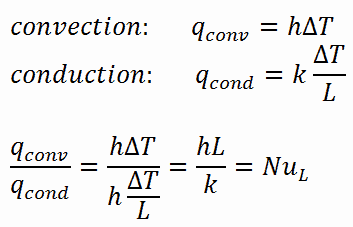Useful dimensionless numbers with description
Important Forces before starting:
Ratio of inertial forces to viscous forces.
(dimensionless)
Reynold number = (density)*(velocity)*(Diameter)/(Dynamic viscosity)
The ratio
ν = µ/ρ is termed the kinematic viscosity.
Reynold number is used to categorize the fluids systems in which the effect of viscosity is important in controlling the velocities or the flow pattern of a fluid.
Flow in a pipe is laminar if the Reynolds Number (based on diameter of the pipe) is less than 2100 and is turbulent if it is greater than 4000.
Transitional Flow prevails between these two limits.
Capillary number :
Ratio of viscous force to interfacial force.
It is used while flooding or EOR.
More the capillary number, higher the oil recovery.
Capillary number = (Dynamic viscosity)*(Velocity)/(interfacial tension)
For a flowing liquid, if NC >>1, then viscous forces dominate over interfacial forces; however
if NC <<1, then viscous forces are negligible compared with interfacial forces.
Capillary numbers are usually large for high-speed flows and low for low-speed flows; thus, typically for flow through pores in the reservoir NC is ~10−6, and for flow in production tubulars NC is ~1.
Froude number :
Ratio of inertia force to the gravitational force.
Froude number = (velocity of flow)/square root of [(length of flow)*(acceleration due to gravity)]
Froude number is useful to describe the flow in open channels, flow over notches and weirs, the motion of a ship in turbulent sea conditions (ship resistance), flow over spillways, etc.
Fr = 1, critical flow,
Fr > 1, supercritical flow (fast rapid flow),
Fr < 1, subcritical flow (slow / tranquil flow)
Nusselt number :
Ratio of convective to conductive heat transfer at a boundary in a fluid. (dimensionless)
Nusselt Number : Nu = hL/k.
Where, h = Convection Heat Transfer Coefficient, L = Characteristic Length, k = Thermal Conductivity of the Fluid.
Nusselt number can never be less than 1.
Used in calculations of heat transfer between a moving fluid and a solid body.
Mach number :
Ratio of inertia force to the elastic force.
If the Mach number is one, then the flow velocity is equal to the velocity of sound in the fluid.
If it is less than one, then the flow is called subsonic flow, and
If it is greater than one the flow is called supersonic flow.
Euler’s number :
Ratio of inertia force to the pressure force.
Euler's number = (velocity of fluid)/under root of{(pressure)/(density of fluid)}
Euler’s number is significant in cases where pressure gradient exists such as flow through pipes, water hammer pressure in penstocks, discharge through orifices and mouthpieces, etc.
Bond number or
Eötvös number :
Ratio of the gravitational force (mg, where m is the mass and g is the acceleration of gravity) to the force due to surface tension γL (where γ is the surface tension and L is some characteristic length such as the radius for a sphere)
Bo = mg/γL
For spherical bubbles,
Bond number = (ρ - ρ′) L 2 g /σ,
where ρ is the density of a bubble or drop, ρ′ is the density of the surrounding medium, L is a characteristic dimension, g is the acceleration of gravity, and σ is the surface tension of the bubble or drop.
A value of Nb <<1 implies the flow is only weakly dependent on gravitational forces,
Nb >>1 implies gravitational forces dominate over interfacial forces.
Stokes Number :
Stoke Number = (relaxation time)*(fluid velocity)/(characteristic dimension of the obstacle (typically its diameter))
Wave number :
reciprocal of wavelength, so the number of wave cycles per unit of distance, abbreviated as k.
Weber number :
The Weber number is defined as
We=ρg *Vr2 * L/σ
where ρg is the gas mass density (kg/m3), Vr is the relative velocity between gas and liquid (m/s), L the drop or liquid jet diameter (m), and σ (N/m) the surface tension of the liquid.
Useful in analysing fluid flows where there is an interface between two different fluids, especially for multiphase flows with strongly curved surfaces.
prandtl number :
prandtl number = cp* v / k,
where c p is the heat capacity per unit volume of the fluid,
v its kinematic viscosity, and
k its thermal conductivity.
Used in calculations of heat transfer between a moving fluid and a solid body.
grashof number :
Ratio of the buoyant to viscous force acting on a fluid in the velocity boundary layer.
It shows, how dominant is the buoyancy force which is responsible for the convection comparing to the viscous forces.
Rayleigh Number :
Rayleigh number, Ra= Gr*Pr
Gr = Grashof number
Pr = prandtl number
The most important use of the Rayleigh number is to characterize the laminar to turbulence transition of a free convection boundary layer flow
Sherwood number :
It represents the ratio of the convective mass transfer to the rate of diffusive mass transport.
Sherwood Number : Sh = kl/D.
where, k = Mass Transfer Coefficient,
L = Characteristic Length,
D = Diffusion Coefficient
Used in mass-transfer operation.
For other Numbers, see these images:





















Comments
Post a Comment